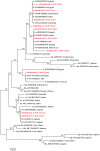HCV infection among Saudi population: high prevalence of genotype 4 and increased viral clearance rate
- PMID: 22253780
- PMCID: PMC3258249
- DOI: 10.1371/journal.pone.0029781
HCV infection among Saudi population: high prevalence of genotype 4 and increased viral clearance rate
Abstract
HCV is a major etiological agent of liver disease with a high rate of chronic evolution. The virus possesses 6 genotypes with many subtypes. The rate of spontaneous clearance among HCV infected individuals denotes a genetic determinant factor. The current study was designed in order to estimate the rate of HCV infection and ratio of virus clearance among a group of infected patients in Saudi Arabia from 2008 to 2011. It was additionally designed to determine the genotypes of the HCV in persistently infected patients. HCV seroprevalence was conducted on a total of 15,323 individuals. Seropositive individuals were tested by Cobas AmpliPrep/Cobas TaqMan HCV assay to determine the ratio of persistently infected patients to those who showed spontaneous viral clearance. HCV genotyping on random samples from persistently infected patients were conducted based on the differences in the 5'untranslated region (5'UTR). Anti-HCV antibodies were detected in 7.3% of the totally examined sera. A high percentage of the HCV infected individuals experienced virus clearance (48.4%). HCV genotyping revealed the presence of genotypes 1 and 4, the latter represented 97.6% of the tested strains. Evidences of the widespread of the HCV genotype 4 and a high rate of HCV virus clearance were found in Saudi Arabia.
Conflict of interest statement
Figures



Similar articles
-
An 11-year retrospective study on hepatitis C in Saudi Arabia: Seroconversion, recovery rates, and viral genotype distribution.Virology. 2025 Jun;607:110505. doi: 10.1016/j.virol.2025.110505. Epub 2025 Mar 21. Virology. 2025. PMID: 40174332
-
Genotyping of hepatitis C virus isolates by a new line probe assay using sequence information from both the 5'untranslated and the core regions.J Virol Methods. 2007 Aug;143(2):153-60. doi: 10.1016/j.jviromet.2007.03.006. Epub 2007 Apr 25. J Virol Methods. 2007. PMID: 17462747
-
Characterization of hepatitis C virus genotypes by direct sequencing of HCV 5'UTR region of isolates from Saudi Arabia.PLoS One. 2014 Aug 6;9(8):e103160. doi: 10.1371/journal.pone.0103160. eCollection 2014. PLoS One. 2014. PMID: 25099694 Free PMC article. Clinical Trial.
-
Prevailing genotypes of hepatitis C virus in Saudi Arabia: a systematic analysis of evidence.Ann Saudi Med. 2013 Jan-Feb;33(1):1-5. doi: 10.5144/0256-4947.2013.1. Ann Saudi Med. 2013. PMID: 23458931 Free PMC article. Review.
-
Hepatitis C virus genotypes in Saudi Arabia.Saudi Med J. 2002 Jan;23(1):7-12. Saudi Med J. 2002. PMID: 11938356 Review.
Cited by
-
Virological surveillance, molecular phylogeny, and evolutionary dynamics of hepatitis C virus subtypes 1a and 4a isolates in patients from Saudi Arabia.Saudi J Biol Sci. 2021 Mar;28(3):1664-1677. doi: 10.1016/j.sjbs.2020.11.089. Epub 2020 Dec 8. Saudi J Biol Sci. 2021. PMID: 33732052 Free PMC article.
-
Genetic Subtypes and Natural Resistance Mutations in HCV Genotype 4 Infected Saudi Arabian Patients.Viruses. 2021 Sep 14;13(9):1832. doi: 10.3390/v13091832. Viruses. 2021. PMID: 34578414 Free PMC article.
-
Detection of anti-HCV antibodies in the clinical classification and epidemiological surveillance of HCV infection.Mol Biol Rep. 2025 Jul 17;52(1):730. doi: 10.1007/s11033-025-10827-2. Mol Biol Rep. 2025. PMID: 40676404 Review.
-
Prevalence of occult hepatitis C virus among hemodialysis patients in Tanta university hospitals: a single-center study.Environ Sci Pollut Res Int. 2018 Feb;25(6):5459-5464. doi: 10.1007/s11356-017-0897-y. Epub 2017 Dec 6. Environ Sci Pollut Res Int. 2018. PMID: 29214477
-
A novel candidate hepatitis C virus genotype 4 subtype identified by next generation sequencing full-genome characterization in a patient from Saudi Arabia.Front Microbiol. 2023 Nov 2;14:1285367. doi: 10.3389/fmicb.2023.1285367. eCollection 2023. Front Microbiol. 2023. PMID: 38029191 Free PMC article.
References
-
- Simmonds P, Alberti A, Alter HJ, Bonino F, Bradley DW, et al. A proposed system for the nomenclature of hepatitis C viral genotypes. Hepatology. 1994;19:1321–1324. - PubMed
-
- Kuiken C, Simmonds P. Nomenclature and numbering of the hepatitis C virus. Methods Mol Biol. 2009;510:33–53. - PubMed
-
- Khattab MA, Ferenci P, Hadziyannis SJ, Colombo M, Manns MP, et al. Management of hepatitis C virus genotype 4: recommendations of an international expert panel. J Hepatol. 2011;54:1250–1262. - PubMed
-
- Al-Faleh F, Huraib S, Sbeih F, Al-Karawi M, Al-Rashed R, et al. Hepatitis C virus genotypes in patients with chronic liver disease and haemodialysis patients from Saudi Arabia. J Viral Hepat. 1995;2:293–296. - PubMed
Publication types
MeSH terms
Substances
Associated data
- Actions
- Actions
- Actions
- Actions
- Actions
- Actions
- Actions
- Actions
- Actions
- Actions
LinkOut - more resources
Full Text Sources
Medical
Molecular Biology Databases

